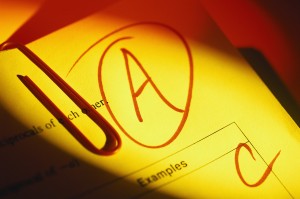This coming September 2012 I will begin my 25th year teaching at Baruch College (City University of New York). I am proud to be a member of the Department of Journalism where I teach a panoply of courses in media and culture, including multimedia reporting, introduction to business communication, and courses dealing with jazz and music generally.
At the end of each semester I am required to give each student a grade. For the most part, the “A” students are easy to identify, just as the lower grade students are. The “B” and “C” students are somewhat harder, but by the end of the semester, after numerous assignments, and 14 week’s worth of interactions with each student, I usually have a strong sense of what grade a student deserves.
My grading criteria emphasize quality of writing, class participation, timeliness, consistency, and observable growth. I tend to look at the trend of the grades. A student might start out at the beginning of the semester as a “B” student but could very well end up as an “A-” or an “A” student by the end of the semester. To a large degree, it has to do with my overall impression of the student’s character, together with all the other elements determines a student’s final grade. I have given final grades to thousands of students. Rarely has there been a problem.
This past spring 2012 semester, however, the grade gremlins came out of the woodwork: one student was discovered to have plagiarized final papers in two courses: in mine the level of plagiarism was 77%! Two students expressed their angst that the “B” and “B+” grades they received were unwarranted. “No way was my final grade less than an A-,” one student argued. And in one class I dropped three students for poor attendance. Two of the three students were drop-jawed in response to my apparent audacious decision. Never mind they came to class whenever they deemed it necessary and when they did it was always late. Another student gave me the impression it was her choice as to what assignments should be completed. She received a C+.
This apparent avalanche of problems with student grades (at least from the students’ perspective), especially the student who committed plagiarism, gave me pause. For years colleagues in my own and other departments had from time to time expressed their concern about plagiarism and grade inflation– my own department had even prepared a handout dealing with plagiarism–but it had never hit me in the face as it did this past semester.
I did some cursory research. This is what I found.
According to an October 2006 article published by Bloomberg: “Plagiarism on U.S. campuses is on the rise. Of 51,611 undergraduates surveyed in a 2005 study by Duke University’s Center for Academic Integrity, 37 percent admitted copying Internet material without attribution, compared with 10 percent in 1999.” The article went on to point out that faculty are reluctant to use plagiarism detection software, such as Turnitin.com, because they don’t want to “police” the classroom, or because they believe few students plagiarize.
Another Bloomberg article: “MBA students cheat more than other graduate students, according to a study for the Center for Academic Integrity at Duke University. The study found 56 percent of business students acknowledged cheating, compared with 54 percent in engineering, 48 percent in education, and 45 percent in law school.”
A 2010 article in The New Yorker quoted a student as saying: “In the digital age, plagiarism isn’t and shouldn’t be as big a deal as it used to be when people used books [i.e., texts] for research.”
A June 4, 2012 article from the Pittsburgh Post-Gazette: “In national surveys of more than 80,000 college students conducted from 2002 until this spring, nearly half admitted they cheated via the Internet. . . .”
And finally, there’s this June 2012 story from The Chronicle of Higher Education: “Take Bob Smith, a student at a public university in the United States. This past semester, he spent just 25 to 30 minutes each week on an online science course, the time it took him to take the weekly test. He never read the online materials for the course and never cracked open a textbook. He learned almost nothing. He got an A.
“His secret was to cheat, and he’s proud of the method he came up with—though he asked that his real name and college not be used, because he doesn’t want to get caught. It involved four friends and a shared Google Doc, an online word-processing file that all five of them could read and add to at the same time during the test.”
The Characteristics of the Internet
What is it about the characteristics of the Internet that engenders the apparent growing epidemic of cheating on college campuses? Is it the Internet’s encyclopedic content? One’s ability to access this information 24/7? The ease with which one can download content and “plug” it into a class paper, for example, and call it one’s own? Is it the fact that much on the Internet is available for free–such as all sorts of content, software, and music? And because it is free, the general impression given is its use is also free and does not require either attribution or royalties?
What students don’t seem to appreciate is that over the course of a semester a professor gets a sense of a student’s writing style, skill, and vocabulary. Every student has a unique writing style. So when a paper shows up with a lexicon that is clearly outside a student’s acumen, it raises a red flag.
![Blog 15 #3 Flying Hi[1]](http://www.eugenemarlow.com/wp-content/uploads/2012/06/Blog-15-3-Flying-Hi1-300x272.jpg) But let’s take a look at the other side of the coin, so to speak. Students today are under a great deal of pressure. At the public university where I teach a large majority of students work part-time, some even work full-time. Is this an issue? College tuition debt is a real problem with no end in sight. Many students have to work. Moreover, the “recession economy” of the last four years has made future employment potential a real obstacle. Students need tuition assistance, as much scholarship funding as they can get their hands on, and a strong academic resume by the time they graduate.
But let’s take a look at the other side of the coin, so to speak. Students today are under a great deal of pressure. At the public university where I teach a large majority of students work part-time, some even work full-time. Is this an issue? College tuition debt is a real problem with no end in sight. Many students have to work. Moreover, the “recession economy” of the last four years has made future employment potential a real obstacle. Students need tuition assistance, as much scholarship funding as they can get their hands on, and a strong academic resume by the time they graduate.
Is all this fostering a culture where students will do anything to look good on paper, including demanding higher grades of professors (because they perceive they deserve it) and plagiarism?
When I was an undergraduate college junior and senior, I worked full time (35 hours a week) at night and on weekends for a Wall Street law firm. When I began my doctoral studies I was a corporate manager with 15 people in my employ, plus a host of freelancers, responsible for a seven figure expense budget. Am I making an unfair comparison? Perhaps. But consider previous generations that did not have access to the Internet? Who also went to college during recessions, who also had to work in order to pay for college? Who also sent money home to help support their family? Who were drafted into the military and survived but then gained the GI Bill that allowed them to earn a college degree? Were these prior generations under any less pressure than today’s college students?
In a sense the Internet’s easy access to free information characteristic parallels the 30-minute sitcom where every problem is resolved before the last commercial, the 30-second commercial that purveys a solution to every problem, where politicians spout long-term solutions in 15-second sound bytes, and mobile devices provide almost instant communication with people and content globally.
The electronic media landscape—where information travels at the speed of light—has engendered a culture where anything less than “instant” is anathema. As students become more mature adults, at least chronologically, they discover that “instant” is not as easy as it looks. That there is a very long history of technological evolution behind the push-button world they were brought into.
The Professor’s Role
![Blog 15 #5[1]](http://www.eugenemarlow.com/wp-content/uploads/2012/06/Blog-15-51.jpg) From the professorial side this is a message that must be brought into the classroom. For me, assignments require students to quote from books, seek out professional and trade publications, join professional associations (as student members), explore government reports, and especially seek out face-to-face meetings and interviews with subject experts. I tell my students Wikipedia is a nice place to start, but not to finish. I limit the amount of quoting from Internet only sources.
From the professorial side this is a message that must be brought into the classroom. For me, assignments require students to quote from books, seek out professional and trade publications, join professional associations (as student members), explore government reports, and especially seek out face-to-face meetings and interviews with subject experts. I tell my students Wikipedia is a nice place to start, but not to finish. I limit the amount of quoting from Internet only sources.
It’s ironic that the Internet with its apparent global reach—presently only one-third of the world’s population has access—does not foster among students a desire to touch the real world. The virtual world of the Internet is not a magic pill. It’s an option as a research tool.
What is not an option is the role of the professor. Earlier I referenced that faculty are reluctant to use plagiarism detection software, such as Turnitin.com, because they don’t want to “police” the classroom, or because they believe few students plagiarize. Perhaps it is also that faculty don’t want to be perceived as mean. They want good student evaluations. This attitude is detrimental to the students. It’s also unethical. If professors don’t demand of their students—and this includes giving attribution where attribution is due—students will not reach for that high bar.
Part of the professor’s role (any teacher for that matter) is to keep raising the bar. A line from British poet Robert Browning applies here: “Man’s reach should exceed his grasp, or what’s a heaven for?” If we accept cheating and plagiarism as a way of college student life, we will end up with a generation that perceives doing as little as possible and relying on others to do the heavy lifting is the way to get ahead and through life.
Of course, it isn’t.
Please write to me at meiienterprises@aol.com if you have any comments on this or any other of my blogs.
Eugene Marlow, Ph.D.
June 18, 2012
© Eugene Marlow 2012



![Blog 15 #2 Two-face[1]](http://www.eugenemarlow.com/wp-content/uploads/2012/06/Blog-15-2-Two-face1.jpg)
